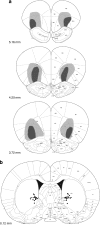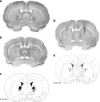The role of the striatum in compulsive behavior in intact and orbitofrontal-cortex-lesioned rats: possible involvement of the serotonergic system
- PMID: 20072118
- PMCID: PMC3055356
- DOI: 10.1038/npp.2009.208
The role of the striatum in compulsive behavior in intact and orbitofrontal-cortex-lesioned rats: possible involvement of the serotonergic system
Abstract
In the signal attenuation rat model of obsessive-compulsive disorder (OCD), 'compulsive' behavior is induced by attenuating a signal indicating that a lever-press response was effective in producing food. We have recently found that lesions to the rat orbitofrontal cortex (OFC) led to an increase in compulsive lever-pressing that was prevented by systemic administration of the selective serotonin reuptake inhibitor paroxetine, and paralleled by an increase in the density of the striatal serotonin transporter. This study further explored the interaction between the OFC, the striatum, and the serotonergic system in the production of compulsive lever-pressing. Experiment 1 revealed that OFC lesions decrease the content of serotonin, dopamine, glutamate, and GABA in the striatum. Experiment 2 showed that intrastriatal administration of paroxetine blocked OFC lesion-induced increased compulsivity, but did not affect compulsive responding in intact rats. Experiments 3 and 4 found that pre-training striatal lesions had no effect on compulsive lever-pressing, whereas post-training striatal inactivation exerted an anticompulsive effect. These results strongly implicate the striatum in the expression of compulsive lever-pressing in both intact and OFC-lesioned rats. Furthermore, the results support the possibility that in a subpopulation of OCD patients a primary pathology of the OFC leads to a dysregulation of the striatal serotonergic system, which is manifested in compulsive behavior, and that antiobsessional/anticompulsive drugs exerts their effects, in these patients, by normalizing the dysfunctional striatal serotonergic system.
Figures






Similar articles
-
'Compulsive' lever-pressing in rats is attenuated by the serotonin re-uptake inhibitors paroxetine and fluvoxamine but not by the tricyclic antidepressant desipramine or the anxiolytic diazepam.Behav Pharmacol. 2004 May;15(3):241-52. Behav Pharmacol. 2004. PMID: 15187582
-
Role of the orbital cortex and of the serotonergic system in a rat model of obsessive compulsive disorder.Neuroscience. 2005;130(1):25-36. doi: 10.1016/j.neuroscience.2004.08.037. Neuroscience. 2005. PMID: 15561422
-
Strain differences in 'compulsive' lever-pressing.Behav Brain Res. 2007 Apr 16;179(1):141-51. doi: 10.1016/j.bbr.2007.01.014. Epub 2007 Jan 31. Behav Brain Res. 2007. PMID: 17320982
-
The signal attenuation rat model of obsessive-compulsive disorder: a review.Psychopharmacology (Berl). 2006 Jul;186(4):487-503. doi: 10.1007/s00213-006-0387-2. Psychopharmacology (Berl). 2006. PMID: 16718482 Review.
-
The orbitofrontal cortex, food intake and obesity.J Psychiatry Neurosci. 2020 Sep 1;45(5):304-312. doi: 10.1503/jpn.190163. J Psychiatry Neurosci. 2020. PMID: 32167268 Free PMC article. Review.
Cited by
-
Molecular and anatomical organization of the dorsal raphe nucleus.Elife. 2019 Aug 14;8:e46464. doi: 10.7554/eLife.46464. Elife. 2019. PMID: 31411560 Free PMC article.
-
Orbitofrontal Cortex Signals Expected Outcomes with Predictive Codes When Stable Contingencies Promote the Integration of Reward History.J Neurosci. 2017 Feb 22;37(8):2010-2021. doi: 10.1523/JNEUROSCI.2951-16.2016. Epub 2017 Jan 23. J Neurosci. 2017. PMID: 28115481 Free PMC article.
-
Unlocking the reinforcement-learning circuits of the orbitofrontal cortex.Behav Neurosci. 2021 Apr;135(2):120-128. doi: 10.1037/bne0000414. Behav Neurosci. 2021. PMID: 34060870 Free PMC article.
-
Dopamine, but not serotonin, regulates reversal learning in the marmoset caudate nucleus.J Neurosci. 2011 Mar 16;31(11):4290-7. doi: 10.1523/JNEUROSCI.5066-10.2011. J Neurosci. 2011. PMID: 21411670 Free PMC article.
-
Impaired formation of stimulus-response, but not action-outcome, associations in rats with methamphetamine-induced neurotoxicity.Neuropsychopharmacology. 2011 Nov;36(12):2441-51. doi: 10.1038/npp.2011.131. Epub 2011 Jul 20. Neuropsychopharmacology. 2011. PMID: 21775980 Free PMC article.
References
-
- Abellan MT, Martin-Ruiz R, Artigas F. Local modulation of the 5-ht release in the dorsal striatum of the rat: an in vivo microdialysis study. Eur Neuropsychopharmacol. 2000;10:455–462. - PubMed
-
- Aouizerate B, Guehl D, Cuny E, Rougier A, Bioulac B, Tignol J, et al. Pathophysiology of obsessive-compulsive disorder: a necessary link between phenomenology, neuropsychology, imagery and physiology. Prog Neurobiol. 2004;72:195–221. - PubMed
-
- Balleine BW. Neural bases of food-seeking: affect, arousal and reward in corticostriatolimbic circuits. Physiol Behav. 2005;86:717–730. - PubMed
-
- Baxter LR, Jr, Schwartz JM, Bergman KS, Szuba MP, Guze BH, Mazziotta JC, et al. Caudate glucose metabolic rate changes with both drug and behavior therapy for obsessive-compulsive disorder. Arch Gen Psychiatry. 1992;49:681–689. - PubMed
Publication types
MeSH terms
Substances
LinkOut - more resources
Full Text Sources

